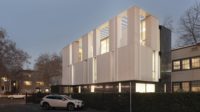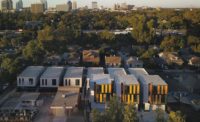Just a stone’s throw from Lake Michigan, in a neighborhood of postwar single-family homes, Johnsen Schmaling Architects has designed a vibrant house for a couple that enjoys entertaining but also values privacy and serenity. Nestled into a sloped site, the split-level structure’s interlocking volumes separate public and private wings, defining several outdoor spaces.
A deeply recessed entrance leads directly to the center of the T-shaped house. On one side is the open living, dining, and kitchen area, its ceiling and walls wrapped with white oak. A glasswalled staircase leads up to the fireplace-centered observatory and down to the guest suite and a sunken patio. On the opposite side of the entrance, a linear, one-story, cedar-clad wing contains the master bedroom, a large double bath, a secluded garden, and the garage. The architects chose the furnishings and worked with the clients to select, frame, and hang art from their collection.
Additional Information:Jump to credits & specifications
“Much of our discussion with the clients focused on how to create a mood-enhancing space,” says Sebastian Schmaling. Organized around perpendicular axes of activity, the home’s layout contributes to a sense of order and peacefulness, while material and color choices help the building harmonize with its forested context.
“The site is lush and verdant in the summer,” Schmaling explains, “but things change very dramatically with the seasons. Winters here are harsh, and there’s a long period when everything’s just gray, brown, and white.” As a result, the Milwaukee-based design team infused the public volume with different shades of green, matching the interior walls to the painted fiber cement panels of the facade, which are interspersed with floor-to-ceiling glazing between layers of white brick. “It lifts your spirits when you look outside during the winter,” says Schmaling. The wavelength of visible green light, 510 nanometers, became the house’s namesake.
While some sustainability choices, like high-efficiency glazing and geothermal heating and cooling, are functional but not readily evident, the green roof, which reduces stormwater runoff and increases insulation, also improves the occupants’ living experience. “Environmentally, it’s great,” says Schmaling. But visually and functionally, he adds, it’s a boon for the couple—and for their two dogs. “They look out from the observatory at grass instead of just roof and membrane, and have another point of access to the outdoors from their home.”
CreditsArchitect: Johnsen Schmaling Architects
Personnel in architect's firm who should receive special credit: Principals-in-Charge: Interior designer: Johnsen Schmaling Architects
Engineers Structural: Core 4 Engineering
Consultants Landscape: Johnsen Schmaling Architects
General contractor: JM Construction
Photographer: John J. Macaulay; P: 414.708.7687
|
SpecificationsStructural System Steel and wood frame hybrid Exterior Cladding Masonry: Northfield Wood: Inladn Red Cedar Moisture barrier: Tyvek, VaproShield Roofing Johns Manville Windows Wood frame: Marvin Glazing Glass: Oldcastle BuildingEnvelope Doors Entrances: Quantum Wood doors: Quantum Upswinging doors, other: Super Sneaky Hardware Locksets: Schlage Interior Finishes Paints and stains: Benjamin Moore Floor tile:Caesar Lighting Interior ambient lighting: Tech Lighting Downlights: Tech Lighting; Cooper Lumiere Exterior: Cooper Lumiere; Lumini |
















